冷轧板带钢课程设计
板带钢轧制工艺课程设计

板带钢轧制工艺课程设计一、课程目标知识目标:1. 学生能够理解并掌握板带钢轧制工艺的基本概念、工艺流程及各阶段的关键技术参数。
2. 学生能够了解板带钢轧制过程中的力学行为、变形规律及质量控制要点。
3. 学生能够掌握影响板带钢轧制质量的常见因素,并了解相应的解决措施。
技能目标:1. 学生能够运用所学知识,分析并解决板带钢轧制过程中出现的问题。
2. 学生能够设计简单的板带钢轧制工艺方案,并进行初步的工艺优化。
3. 学生能够运用相关软件或工具,进行板带钢轧制过程的模拟与分析。
情感态度价值观目标:1. 学生能够认识到板带钢轧制工艺在国民经济发展中的重要作用,增强对材料加工行业的兴趣和责任感。
2. 学生能够培养严谨的科学态度,善于合作、沟通交流,提高团队协作能力。
3. 学生能够关注板带钢轧制工艺的环保和可持续发展问题,提高环保意识。
课程性质:本课程为专业技术课程,旨在帮助学生掌握板带钢轧制工艺的基本知识和实践技能,培养学生解决实际问题的能力。
学生特点:高二年级学生,具有一定的物理、数学基础,对工程技术有一定兴趣,思维活跃,动手能力强。
教学要求:结合学生特点,注重理论联系实际,强化实践教学,提高学生的实际操作能力和创新能力。
通过课程学习,使学生能够达到上述知识、技能和情感态度价值观目标,为未来从事相关工作奠定基础。
二、教学内容1. 板带钢轧制工艺概述:介绍板带钢的定义、分类及应用,使学生了解板带钢轧制工艺的基本概念和行业背景。
教材章节:第一章,第一节2. 板带钢轧制工艺流程:讲解板带钢轧制工艺的各个阶段,包括加热、粗轧、精轧、冷却等,分析各阶段的技术参数和关键设备。
教材章节:第一章,第二节3. 板带钢轧制过程中的力学行为与变形规律:探讨板带钢在轧制过程中的力学行为、变形规律,以及轧制力、轧制力矩的计算方法。
教材章节:第二章,第一节4. 板带钢轧制质量控制:分析影响板带钢轧制质量的各种因素,如板形、板厚、力学性能等,并介绍相应的质量控制措施。
《板带钢轧制》课程标准

《板带钢轧制工艺操作》学习领域课程标准学习领域课程名称:板带钢轧制工艺操作适用专业:高等职业技术学院材料工程技术专业(轧钢方向)1、课程定位与设计思路1.1 课程定位关键词:课程地位、主要功能、课程间相互关系。
课程地位:本课程是高等职业院学材料工程技术专业(轧钢方向)的一门专业核心课程、专业必修课程。
主要功能:使学生掌握板带钢的分类、生产工艺过程及板带钢轧制的最新发展趋势,能熟练掌握和编制板带钢生产工艺规程报告、工艺设备安装与调试操作、设备的日常保养维护,能对板带钢轧制生产中一般性工艺和设备故障进行正确判断与排除;具备轧钢调整工和工艺编制员初步能力。
(由一个初学者→高级初学者→有能力者→熟练者→专家)并能按照轧制生产工艺要求完成板带钢轧制的完整操作,使学生初步具备高等技术人才应有的生产操作的技能、独立分析问题和解决现场实际问题及组织安排安全生产的能力。
课程间相互关系:本课程以“金属材料热处理”、“塑性变形及技术应用”、“轧钢设备操作与维护”、“板带钢顶岗实训”等课程的学习为基础,并与“孔型与辊型技术及应用”、“钢材生产过程检测技术及应用”等课程相衔接。
1.2 设计思路关键词:课程开设依据、内容选择标准、学习领域载体设计思路、内容编排顺序(能力递进)、学习程度用语、课时和学分。
本课程的总体设计思路:打破以知识传授为主要特征的传统学科课程模式,从“工作任务与职业能力”分析出发,设定职业能力培养目标,变书本知识的传授为动手能力的培养,开发基于工作过程的项目课程,以生产产品或品种为工作任务载体组织课程内容,在完成一个个具体的工作任务过程中来构建相关理论知识,并发展职业能力。
课程开设依据:本课程是高职高专材料工程技术专业(轧钢方向)学生就业后从事的主要岗位群,根据岗位群所面对的各工作任务领域设置了该课程。
本课程的主要功能是使学生懂得板带钢轧制的基本生产工艺制度、会基本工艺规程编制和工艺调整操作、会操作、维护和保养生产设备、能完成轧制板带钢材的完整工艺编制与实施操作,使之具备轧制板带钢材的工艺规程编制、轧机调整等工作的基本能力。
板带钢轧制工艺课程设计(新)

(4)计算轧制压力、轧制力矩及总传动力矩。
(5)校核轧辊等部件的强度和电机过载过热能力。
(6)按前述制订轧制规程的原则和要求进行必要的修正和改进。
2.3.2 道次压下量的影响与分配
(1)限制道次压下量的因素
限制道次压下量的因素有金属塑性、咬入条件、轧辊强度及接轴叉头等的强度条件、轧制质量。
图2-1两种道次压下量的分配规律
从上述压下量分配来看,总的趋势是压下量由大到小,但是相对压下量 在相当多的道次范围内却是逐渐上升的。咬入角的限制一般只在开始道次起作用,板形限制一般只在终了1~2道次起作用,中间道次可按轧辊强度和电机能力所允许的最大压下量(这部分约占1/3以上的道次)。这部分的压下量分配有两种方法可供选择:一种是等强度的方法,即使金属对轧辊的压力按道次(在连轧机上按机架)是相等的;另一种是等能耗分配方法,即使电机的能耗按道次或机架分配相等,或者当连轧机机座电机功率不相等时,使各电机的相对负荷相等或按某一系数分配(负荷分配系数)。第一种方法充分利用了轧辊强度,由于轧制力相等在连轧时对各架轧辊的摩损相同,有利于统一换辊。第二种方法充分利用了电机的能力,获得较高的轧制速度和小时产量,显然此时在各机架上或各道次上对轧辊的压力将是不同的。这两种方法选择哪一种,视具体条件的薄弱环节而定。如四辊轧机则往往电机功率为限制压下量的因素。
(2-12)
式中 ——主电机的额定力矩;
——主电机的允许过载系数,直流电机 =2.0~2.5;交流同步主电机 =2.5~3.0;
——轧制周期内的最大力矩。
另外,主电机达到允许最大力矩时,其允许持续时间在15S以内,否则主电机温升将超过允许范围。
4)金属塑性的限制
q215冷轧板带钢轧制工艺设计
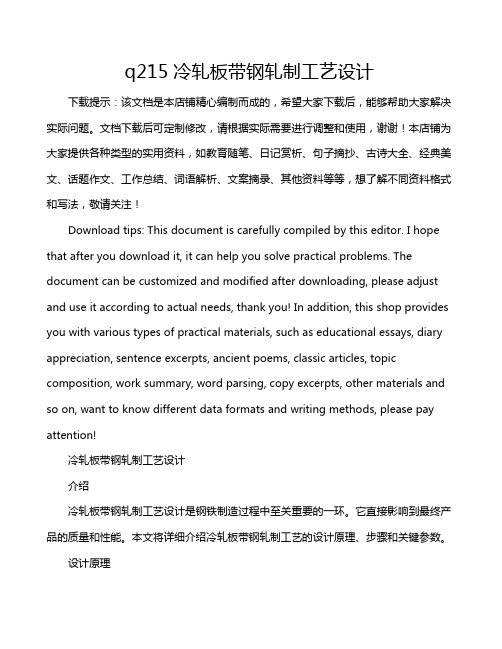
q215冷轧板带钢轧制工艺设计下载提示:该文档是本店铺精心编制而成的,希望大家下载后,能够帮助大家解决实际问题。
文档下载后可定制修改,请根据实际需要进行调整和使用,谢谢!本店铺为大家提供各种类型的实用资料,如教育随笔、日记赏析、句子摘抄、古诗大全、经典美文、话题作文、工作总结、词语解析、文案摘录、其他资料等等,想了解不同资料格式和写法,敬请关注!Download tips: This document is carefully compiled by this editor. I hope that after you download it, it can help you solve practical problems. The document can be customized and modified after downloading, please adjust and use it according to actual needs, thank you! In addition, this shop provides you with various types of practical materials, such as educational essays, diary appreciation, sentence excerpts, ancient poems, classic articles, topic composition, work summary, word parsing, copy excerpts, other materials and so on, want to know different data formats and writing methods, please pay attention!冷轧板带钢轧制工艺设计介绍冷轧板带钢轧制工艺设计是钢铁制造过程中至关重要的一环。
毕业设计(论文)-1x1700mm冷轧带钢压下规程制度
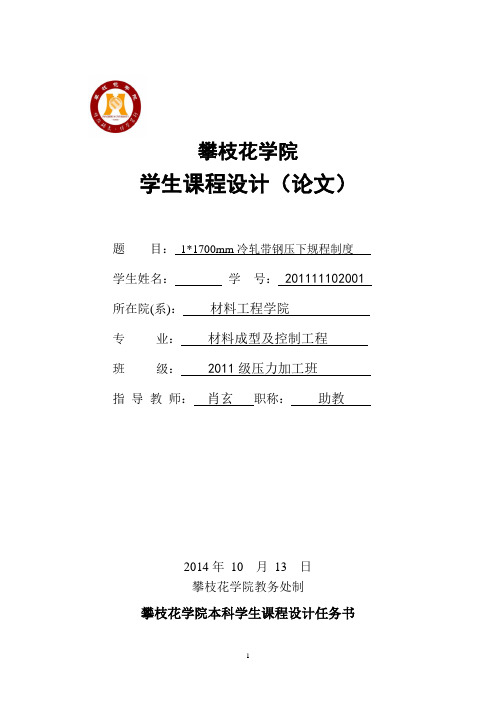
攀枝花学院学生课程设计(论文)题目:1*1700mm冷轧带钢压下规程制度学生姓名:学号: 201111102001 所在院(系):材料工程学院专业:材料成型及控制工程班级: 2011级压力加工班指导教师:肖玄职称:助教2014年10 月13 日攀枝花学院教务处制攀枝花学院本科学生课程设计任务书课程设计(论文)指导教师成绩评定表摘要冷轧带钢具有表面质量高、性能好、品种多和用途广等特点。
特别是汽车工业和家电行业的迅速发展,人们对汽车及家电外壳的质量和性能要求也越来越高,因此发展冷轧板带钢十分必要。
本设计是参照鞍钢五连轧厂而进行的冷轧带钢车间设计,设计年产量120吨。
本设计在参考鞍钢五连轧设备条件下,参照了诸多文献及实际资料,以年产量为基础,结合各产品市场前景合理地分配了个产品产量,并制定了轧制制度,校核了部分只要设备车间年产量,综合了各项技术经济指标,此做了篇关于五连轧压下规程制度的设计。
关键词表面质量,轧制制度,校核,连轧目录1压下规程........................................................................................................... - 6 - 1.1 压下规程确定 ................................................................................................ - 6 - 1.1.1 原料尺寸.. (6)1.1.2 各轧机压下量分配 (6)1.1.3 连轧机组压下量分配及速度制度 (7)1.1.4 五机架连轧各架轧机的压下量分配 (7)1.2 确定轧机速度制度 ......................................................................................... - 8 - 1.2.1 轧制速度的确定.......................................................................................... - 8 - 1.2.2 轧辊转速的确定.. (8)1.2.3 加速度的选择 (9)2力能参数计算 ................................................................................................. - 10 - 2.1 轧制压力的计算........................................................................................... - 10 - 2.2 轧制力矩的计算.......................................................................................... - 13 - 2.2.1轧制力矩的确定 .. (13)2.2.2摩擦力矩的确定 (13)2.2.3轧机的空转力矩(M K) (15)2.2.4动力矩的计算 (16)2.3 电机能力验算 ............................................................................................. - 16 -3 轧辊强度校核 ................................................................................................ - 21 - 3.1 综述 ............................................................................................................ - 21 - 3.2 轧辊强度校核 ............................................................................................. - 21 - 3.2.1支撑辊强度校核........................................................................................ - 21 - 3.2.3工作辊强度校核 (23)3.2.3工作辊与支撑辊间的接触应力 (25)参考文献...................................................................................................... - 29 -1压下规程1.1 压下规程确定压下规程是轧制制度(规程)最基本的核心内容,直接关系着轧机的产量和产品的质量。
年产120万吨1700mm冷轧带钢压下规程课程设计
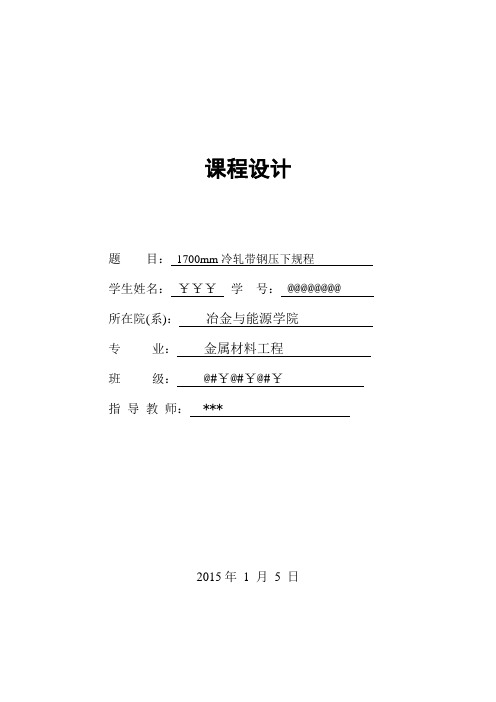
课程设计题目:1700mm冷轧带钢压下规程学生姓名:¥¥¥学号: @@@@@@@@ 所在院(系):冶金与能源学院专业:金属材料工程班级: @#¥@#¥@#¥指导教师: ***2015年1 月5 日摘要冷轧带钢具有表面质量高、性能好、品种多和用途广等特点。
特别是汽车工业和家电行业的迅速发展,人们对汽车及家电外壳的质量和性能要求也越来越高,因此发展冷轧板带钢十分必要。
本设计是参照唐钢五连轧厂而进行的冷轧带钢车间设计,设计年产量120吨。
本设计在参考唐钢五连轧设备条件下,参照了诸多文献及实际资料,以年产量为基础,结合各产品市场前景合理地分配了个产品产量,并制定了轧制制度,校核了部分只要设备车间年产量,综合了各项技术经济指标,此做了篇关于五连轧压下规程制度的设计。
关键词表面质量,轧制制度,校核,连轧目录1压下规程........................................................................................................... - 4 - 1.1 压下规程确定 ................................................................................................ - 4 - 1.1.1 原料尺寸.. (4)1.1.2 各轧机压下量分配 (4)1.1.3 连轧机组压下量分配及速度制度 (5)1.1.4 五机架连轧各架轧机的压下量分配 (5)1.2 确定轧机速度制度 ......................................................................................... - 6 - 1.2.1 轧制速度的确定.......................................................................................... - 6 - 1.2.2 轧辊转速的确定.. (6)1.2.3 加速度的选择 (7)2力能参数计算 ................................................................................................... - 8 - 2.1 轧制压力的计算............................................................................................. - 8 - 2.2 轧制力矩的计算.......................................................................................... - 11 - 2.2.1轧制力矩的确定 .. (11)2.2.2摩擦力矩的确定 (11)2.2.3轧机的空转力矩(M K) (13)2.2.4动力矩的计算 (14)2.3 电机能力验算 ............................................................................................. - 14 -3 轧辊强度校核 ................................................................................................ - 19 - 3.1 综述 ............................................................................................................ - 19 - 3.2 轧辊强度校核 ............................................................................................. - 19 - 3.2.1支撑辊强度校核........................................................................................ - 19 - 3.2.3工作辊强度校核 (21)3.2.3工作辊与支撑辊间的接触应力 (23)1压下规程1.1 压下规程确定压下规程是轧制制度(规程)最基本的核心内容,直接关系着轧机的产量和产品的质量。
北京科技大学-课程设计-年产70万吨冷轧带钢厂的工艺设计

北京科技大学专业课程设计题目:年产70万吨冷轧带钢厂的工艺设计(典型产品:750MPa,0.5×1200×Lmm)班级:材控XXXXX学号:XXXXXX姓名:XXXXX学院:材料科学与工程学院专业名称:材料成型及控制工程指导教师:***20XX年XX月XX日目录一、产品大纲的制定及坯料的选择1.产品方案2.产品大纲3.坯料选择二、工艺流程的制定1.工艺流程2.工艺流程图3.工序描述三、工艺设计1.轧制道次2.压下规程3.轧辊的尺寸设计4.辊径校核5.轧辊的材料及轧机各部分的设计6.张力制度7.速度制度8.润滑制度四、主要设备能力校核1.轧制节奏时间分析2.生产作业时间分配3.产能校核4.轧辊的强度校核五、车间各机组设备选择1.酸洗连轧机组2.连续退火机组3.连续热镀锌机组4.重卷检测机组5.经济核算六、轧钢厂的环境保护1.绿化2.有害物质的控制和预防3.噪声的防治4.水质的处理一、产品大纲的制定及坯料的选择1.产品方案为了满足该厂典型产品的生产需要,并且合理有效的分配该厂的设备进行生产,同时所生产的产品应该具有以下特点:供求适当,品种多样,合理布局,产需平衡,要防止盲目跟风,追求短期效益的情况发生。
不同的产品,轧制时所需要的轧制力不同们需要的动力和消耗的能量也有很大差别,因此对于轧机设备的合理选择以及生产能力的充分利用,是保证经济最大化,轧制专业化发展的必然要求,也利于提高本厂的轧制水平。
冷轧板带钢产品有:CQ级、DQ级、DDQ级、SDDQ级、EDDQ级等,CQ级:商用级,DQ级:冲压级,DDQ级:深冲级,SDDQ级:特深冲级,EDDQ级:超深冲级。
3.冷轧厂所需的原料为热轧钢卷,热轧钢卷的厚度是根据轧机设备生产能力所确定的总压下量决定的,原料宽度根据产品宽度确定,由于一般热轧卷取机的卷筒的直径为:φ760mm,因此冷轧厂的钢卷内经一般为φ760mm,原料的总重量根据成材率确定。
冷轧带钢的工艺及车间设计_毕业设计
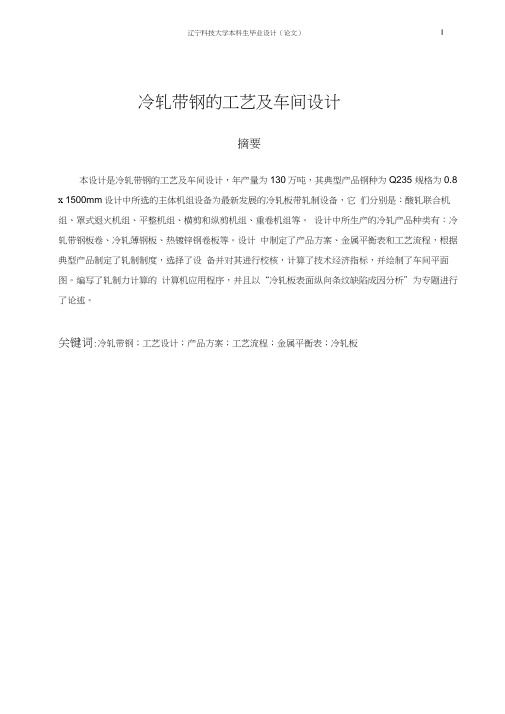
1. ............................................................................................................................ 综 述 ................................................................... 1
1.1 冷轧综述 ................................................................... 1 1.1.1 冷轧定义及优势 ...................................................... 1 1.1.2 冷轧带钢生产的工艺特点 .............................................. 2 1.1.3 冷轧带钢主要产品 .................................................... 3 1.1.4 冷轧产品生产的发展 ................................................... 4 1.1.5 冷轧板带生产现状 .................................................... 5
1.2 冷轧板带生产技术 ........................................................... 6 1.2.1 酸洗技术 ............................................................. 6 1.2.2 轧制技术 ............................................................ 7 1.2.3 平整技术 ............................................................. 8 1.2.4 带钢涂、镀层技术 ..................................................... 8
冷轧课程设计说明书
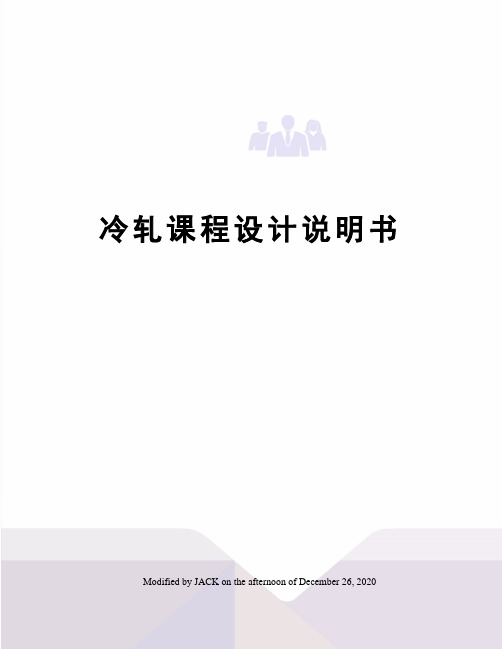
冷轧课程设计说明书 Modified by JACK on the afternoon of December 26, 2020辽宁科技大学课程设计说明书课题:生产Q235 1×1450mm 板带钢指导老师:班级:姓名: 9目录1综述引言冷轧生产过程中由于不进行加热,所以不存在热轧常出现的麻点和氧化铁皮等缺陷,表面质量好、光洁度高。
而且冷轧产品的尺寸精度高,产品的性能和组织能满足一些特殊的使用要求,如电磁性能、深冲性能等。
冷轧的定义:是再结晶下的轧制,但一般理解为使用常温轧制材料的轧制.铝冷轧分为板轧和箔轧.厚度在~以上的称为板,~以下的称为箔.欧美多采用3~6台连续式轧机作为冷轧设备冷轧优点:采用冷轧方法生产带钢优点是很多的,归结起来有以下几点:①能得到热轧方法很难得到的极薄带钢(薄达;②能使产品具有很高且范围很广的力学性能及工艺性能;③能保证获得高精度尺寸、厚度偏差小、沿带钢的宽度及长度方面的厚度均匀,板形良好、表面光洁的各种带钢;④成本低、收效率高;⑤轧制速度快,具有很高的生产率冷轧主要工艺特点与热轧相比较,冷轧板带生产主要有三大特点:加工硬化由于加工硬化,使轧制过程中金属变形抗力增大,轧制压力提高,同时还使金属塑性将低,容易产生脆裂。
当钢种一定时,加工硬化的剧烈程度与冷轧变形程度有关。
当变形量加大使加工硬化超过一定程度后,就不能再继续轧制。
因此,板带材在经受一定的冷轧总变形量后,往往需要软化热处理(再结晶退火或固溶处理),使之恢复塑性,降低抗力,以利于继续轧制。
生产过程中每两次软化热处理之间所完成的冷轧工作,通常称之为一个“轧程”。
在一定轧制条件下,钢质越硬,成品越薄,所需的轧程就越多。
工艺冷却和工艺润滑冷轧过程中产生的剧烈变形热和摩擦热使轧件和轧辊温度升高,故必须采用有效的人工冷却。
轧制速度越高,压下量越大,冷却问题显得越重要。
如何合理的强化冷却成为发展现代高速冷轧机的重要课题。
冷轧带钢生产的工艺流程讲课教案

↓
基本特点:
入库 ← 包装 ← 横切分类或成卷
浅槽酸洗;双
卷双拆,或无头
轧制、酸轧联合,
出现了带钢头尾
焊接;热处理分
罩式和连续式,
可单张包装,也
可成卷包装。
首钢技师学院
冷轧带钢生产的工艺流程
⑸ 完全连续式冷轧生产方法
酸洗机组
→ 冷连轧机冷轧 → 清洗机组 → 连续式退火 → 平整 ↓
入库 ← 包装 ← 表面检查横切分卷机组
改造后 2 3
235 91 13.4
首钢技师学院
冷轧带钢生产的工艺流程
联合式全连续轧机
简介
全连轧机与前面的酸洗机组联合,即为酸洗联 合式全连轧机。
将单一全连轧 机再与其他生产工 序的机组联合,称 为联合式全连轧机 。
全连轧机与后面的连续退火机组联合,即为退 火联合式全连轧机;
首钢技师学院
冷轧带钢生产的工艺流程
酸洗
→ 待轧 →
多机架连轧或单机架可逆式冷轧 → 罩式或连续式退火 ↓
入库 ← 包装 ← 横切分类或成卷 ← 平整
基本特点: 浅槽酸洗,多机架冷轧或单机架可 逆式轧制,热处理分罩式和连续式, 可单张包装,也可成卷包装。
首钢技师学院
冷轧带钢生产的工艺流程
⑷ 现代冷轧生产方法
酸洗 → 待轧 → 双卷双拆冷连轧机冷轧 → 罩式或连续式退火 → 平整
基本特点: 从酸洗、轧制、热处理、平整实现了全连续。
首钢技师学院
冷轧带钢生产的工艺流程 关于全连续轧机的三个分类
单一全连续
联合式全连续
全连续轧机
全联合式全连续
首钢技师学院
冷轧带钢生产的工艺流程
单一全连续轧机
板带钢轧制工艺课程设计指导书
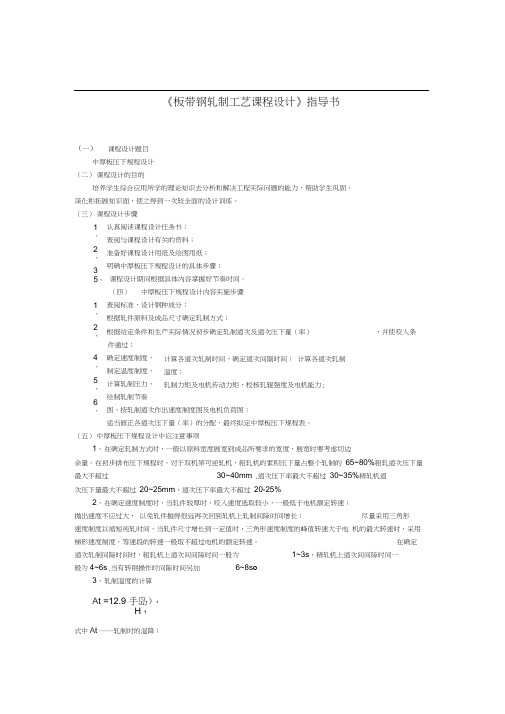
《板带钢轧制工艺课程设计》指导书(一) 课程设计题目中厚板压下规程设计(二) 课程设计的目的培养学生综合应用所学的理论知识去分析和解决工程实际问题的能力,帮助学生巩固、深化和拓展知识面,使之得到一次较全面的设计训练。
(三) 课程设计步骤认真阅读课程设计任务书; 查阅与课程设计有关的资料;准备好课程设计用纸及绘图用纸;明确中厚板压下规程设计的具体步骤; 课程设计期间根据具体内容掌握好节奏时间。
(四) 中厚板压下规程设计内容实施步骤查阅标准,设计钢种成分; 根据轧件原料及成品尺寸确定轧制方式;根据给定条件和生产实际情况初步确定轧制道次及道次压下量(率)件通过; 确定速度制度, 制定温度制度, 计算轧制压力、 绘制轧制节奏图,按轧制道次作出速度制度图及电机负荷图;适当修正各道次压下量(率)的分配,最终拟定中厚板压下规程表。
(五) 中厚板压下规程设计中应注意事项1、 在确定轧制方式时,一般以原料宽度展宽到成品所要求的宽度,展宽时要考虑切边余量。
在初步排布压下规程时,对于双机架可逆轧机,粗轧机的累积压下量占整个轧制的 65~80%粗轧道次压下量最大不超过 30~40mm ,道次压下率最大不超过 30~35%精轧机道次压下量最大不超过 20~25mm ,道次压下率最大不超过 20-25%2、 在确定速度制度时,当轧件较厚时,咬入速度选取较小,一般低于电机额定转速;抛出速度不应过大, 以免轧件抛得很远再次回到轧机上轧制间隙时间增长; 尽量采用三角形 速度制度以缩短纯轧时间,当轧件尺寸增长到一定值时,三角形速度制度的峰值转速大于电 机的最大转速时,采用梯形速度制度,等速段的转速一般取不超过电机的额定转速。
在确定 道次轧制间隙时间时,粗轧机上道次间间隙时间一般为1~3s ,精轧机上道次间间隙时间一 般为4~6s ,当有转钢操作时间隙时间另加 6~8s o3、 轧制温度的计算A t =12.9 手岛)4H 1 式中A t ――轧制时的温降;1、 2、 35、 1、 2、,并使咬入条 计算各道次轧制时间,确定道次间隔时间; 计算各道次轧制温度;轧制力矩及电机传动力矩,校核轧辊强度及电机能力;4、 5、 6、Z ――轧制延续时间(纯轧时间加间隔时间)5、 在校核轧辊强度及电机能力时,轧辊强度可根据材料力学有关知识进行校核;对于电机的过热校核,等效力矩的计算应针对同一块轧件在同一架轧机上轧制的所有道 次各纯轧时间与间隙时间进行计算。
板带钢轧制工艺课程设计指导书

《板带钢轧制工艺课程设计》指导书(一)课程设计题目中厚板压下规程设计(二)课程设计的目的培养学生综合应用所学的理论知识去分析和解决工程实际问题的能力,帮助学生巩固、深化和拓展知识面,使之得到一次较全面的设计训练。
(三)课程设计步骤1、认真阅读课程设计任务书;2、查阅与课程设计有关的资料;3、准备好课程设计用纸及绘图用纸;4、明确中厚板压下规程设计的具体步骤;5、课程设计期间根据具体内容掌握好节奏时间。
(四)中厚板压下规程设计内容实施步骤1、查阅标准,设计钢种成分;2、根据轧件原料及成品尺寸确定轧制方式;3、根据给定条件和生产实际情况初步确定轧制道次及道次压下量(率),并使咬入条件通过;4、确定速度制度,计算各道次轧制时间,确定道次间隔时间;5、制定温度制度,计算各道次轧制温度;6、计算轧制压力、轧制力矩及电机传动力矩,校核轧辊强度及电机能力;7、绘制轧制节奏图,按轧制道次作出速度制度图及电机负荷图;8、适当修正各道次压下量(率)的分配,最终拟定中厚板压下规程表。
(五)中厚板压下规程设计中应注意事项1、在确定轧制方式时,一般以原料宽度展宽到成品所要求的宽度,展宽时要考虑切边余量。
在初步排布压下规程时,对于双机架可逆轧机,粗轧机的累积压下量占整个轧制的65~80%,粗轧道次压下量最大不超过30~40mm,道次压下率最大不超过30~35%;精轧机道次压下量最大不超过20~25mm,道次压下率最大不超过20~25%。
2、在确定速度制度时,当轧件较厚时,咬入速度选取较小,一般低于电机额定转速;抛出速度不应过大,以免轧件抛得很远再次回到轧机上轧制间隙时间增长;尽量采用三角形速度制度以缩短纯轧时间,当轧件尺寸增长到一定值时,三角形速度制度的峰值转速大于电机的最大转速时,采用梯形速度制度,等速段的转速一般取不超过电机的额定转速。
在确定道次轧制间隙时间时,粗轧机上道次间间隙时间一般为1~3s,精轧机上道次间间隙时间一般为4~6s,当有转钢操作时间隙时间另加6~8s。
冷轧课程设计模板(DOC)

冷轧课程设计模板(DOC)辽宁科技⼤学课程设计说明书设计题⽬:冷轧0.55×1400 mm轧制规程设计学院、系:材冶学院专业班级学⽣姓名:指导教师:成绩:年⽉⽇⽬录1冷轧综述 (3)1.1冷轧产品及⽤途 (3)1.2冷轧产品的技术要求 (3)1.3冷轧钢板现状及新技术 (3)1.3.1 我国冷轧板带⽣产现状及前景 (4)1.3.2 冷轧新技术 (4)2⼯艺及规格 (4)2.1冷轧薄板⽣产⼯艺流程 (4)2.2规格 (5)3轧制规程制定 (6)4计算轧制⼒ (7)5设备校核 (11)5.1轧辊各部分尺⼨确定 (11)5.2咬⼊能⼒校核 (12)5.3⽀撑辊强度校核 (13)5.4⼯作辊强度校核 (14)5.5⽀撑辊与⼯作辊接触应⼒校核 (15)5.6电机功率校核 (16)6结束语 (17)冷轧0.55′1400 mm轧制规程设计1冷轧综述1.1冷轧产品及⽤途冷轧产品主要有冷轧板、⾦属镀层薄板、电⼯⽤硅钢板、不锈钢板、超低碳、超深冲IF钢系列、链条⽤钢系列、低碳低硅冷板系列、搪瓷钢系列、⾃⾏车⽤钢系列、烘烤硬化钢系列、含磷钢系列、客车车厢⽤钢板系列、家⽤电器钢板系列、低合⾦钢系硬化钢系列、含磷钢系列、客车车厢⽤钢板系列、家⽤电器钢板系列、低合⾦系列等具有⾼附加值的冷轧钢板产品。
适⽤于制造各种冲压件、钢管及其他⾦属制品。
产品主要⽤于建筑、桥梁、机车车辆、汽车、压⼒容器、锅炉、电器等。
1.2冷轧产品的技术要求板带钢的⽤途⾮常⼴泛,⽤途不同队板带钢的技术要求也就不同。
对板带钢产品的基本要求包括化学成分、⼏何尺⼨、板型、表⾯、性能等⼏个⽅⾯:(1)钢板的化学成分(2)钢板的外形尺⼨(3)钢板板型要求平坦(4)⼒学性能、⼯艺性能、物理性能、化学性能。
1.3冷轧钢板现状及新技术1.3.1 我国冷轧板带⽣产现状及前景我国冷轧板带⽣产需求⼀直旺盛,产能也极快扩张,⾄2010年初步统计,已建和在建的冷轧板带产能约为8400万t~9000万t,共建有冷连宽带钢轧机42台套,单机可逆式宽带钢轧机100余套,冷轧宽带钢⽣产产能的75%以上为冷连机⽣产。
冷轧带钢常识PPT学习教案

冷轧带钢常用牌号对照(5)
GB11253 JIS G DIN
GB710 3141 1623
08
SPCC ST12
EN 1111
08或 08AL
08AL
SPCD ST13 SPCE ST14
SPCEN ST15
第30页/共58页
Q/BQB 402
SPCC ST12 SPCD ST13 SPCE ST14 SPCEN
第28页/共58页
热轧带钢常用牌号对照(4)
GB710 GB711
08
Q/BQB 302
DD11
DIN 1614
Stw22
JIS G 3131
SPHC
EN 111
FeP11
08或08Al DD12 RRstw23 SPHD FeP12
08Al DD13 Stw24 SPHE FeP13
第29页/共58页
φ610 (24”) +20/-50mm
φ760 (30”) +20/-70mm
外径 酸洗开卷最大φ2100mm
1200轧机开卷最大φ2000mm
1450轧机开卷最大φ1900mm
1400轧机开卷最大φ2000mm。
第39页/共58页
千分尺的结构
第40页/共58页
射线测厚仪基本原理
第41页/共58页
蒸气管道 ---- 大红 色环----中黄
压缩空气管道---- 深蓝
液压站供油 ---- 铜棕 色环----白色
乳化液管道 ---- 奶油黄
消防管道 ---- 朱红或橙黄色
酸液
---- 紫色
碱液
---- 中黄
净循环水 ---- 草绿
氮气管道 ---- 浅黄色
冷轧板带钢课程设计Thecurriculumdesignofcoldrolledstrip

冷轧板带钢课程设计( The curriculum design of cold rolledstrip )University of Science and Technology Liaoning curriculum design manual A design rate of 0.75 * 1500mm cold rolled sheetRate of material and metallurgy.Professional rate of material forming and control engineering 09-5 Name rateTeachers rateSuccess rateCatalog1Overview:...:...1.1the concept of cold rolling... And the following:...1.2advantages of cold rolled strip steel:...1.3characteristics of cold rolling technology:...2specifications and processes:2.1specifications: ....... and the following:...2.2cold rolled sheet production and process:...3rolling schedule formulation:...::...3.1pressure down system:...3.2tension system:...:...3.3speed system:...:...4Calculation of rolling force:...:...5equipment strength and capacity check:...5.1bite capacitycheck ..................................................................... (10)5.2roller strength check:...:...5.2.1work rollcheck ..................................................................... ....... Undefined bookmark error rate.5.2.2supporting roll checking:...:...5.3contact stress check:5.4motor power check:5.4.1rolling torque:...:...5.4.2friction torque:...5.4.3idling moment...:...6Summary:... And the following:...1in the process of the review of steel by forging or castingin addition to a small number of methods such as direct outside the timberAbout 80% of the remaining products are rolled. And the production process of cold rolled strip to avoid heatThe disadvantages of existing in the rolling temperature and the temperature uneven division can produce thinner and more precise sizeMake sure that the surface is smoother and the plate shape is more straight.The curriculum design of the cold strip rolling schedule is referred to the 1# line of Anshan Iron and steel cold rolling mill. Pre EngineerStandard Specification for cold rolled sheets of 0.75 * 1500mm. The design of cold-rolled production characteristics and mainworkThe order is simply introduced and established the system of the rolling rolling force calculation of the strength of the roller, electricThe machine power is checked. 1.1 cold rolling concept cold rolling is the rolling process of metal under recrystallization temperature. In cold rolling,metals do not contract againBut the crystal hardening phenomenon will occur. 1.2 cold rolled strip in 1 in the advantage of smaller thickness can sheet production2in the strip along the direction of the length and width of the plate thickness can obtain better shape uniformRoll surface hardness by 3 in the cold can obtain good surface quality of the surface finish1 of the products from4 the strip after cold rolling after heat treatment different mechanical properties of the products can be different. The main technical characteristics of 1.3 cold rolling and hot rolling compared cold strip production has three main features included1 of the work hardeningDueto work hardening makerolling process of metal deformation resistance increases with the increase of rolling pressureWhen the metal plastic will be low prone to brittle fracture.When a violent process of steel hardeningDegree is related to the deformation degree of cold rolling.Whenthe deformation of ambassador hardening exceeds a certain degree is notCan continue rolling?. Therefore strip subjected to certain cold deformationamount after often need softHeat treatment in recrystallization annealing or solid solution treatment to restore the plastic to reduce resistance to theContinuous rolling. The production process of every two times the softening of the complete heat treatment between the cold work often referred toFor a "rolling" process". Required in the rolling process under certain rolling condition steel hard thinner is finishedThe more.2 the process of cooling and lubricationSevere deformation heat and friction heat generated in the process of cold rolled strip and rolls temperature should beEffective artificial cooling shall be used. The rolling speed is higher the greater the amount of pressure cooling problem is more seriousTo. How to reasonably strengthen the cooling becomes an important subject of developing modern high speed cold rolling mill.The main function of the cold rolling process lubrication is metal deformation resistance decreases which not only helpsTo ensure the realization of greater pressure on existing equipment capacity under the condition of but also can makethe mill to economyFeasible to produce products of smaller thickness. In addition adopts the effective lubrication technology of cold rolled over directlyThe heating rate of the process and the temperature rise of the roller play a good influence. In some varieties process run rollingThe utility model can also prevent the metal sticking roller from slipping.The lubricating effect of cold rolling quality is an important indicator to measure the emulsion lubricant requirements are includedWhen the flow of spray and roll surface is can effectively absorb heat and guarantee on the surface of the oil atAgent at a faster speed uniform from the emulsion and segregation of adhesion in surface and the roller surface can formThe oil film thickness uniformity.The 3 tension rollingThe so-called tension rolling is that the rolling deformationof the workpiece is in a certain front tension and back tension2 with the implementation of. The main function of the share of tensionThe strip in the rolling process to prevent deviationThe rolled strip flat and shape goodTo reduce the deformation resistance R for rolling thin productIt can adjust the load of main motor of cold rolling mill properly.2. specifications and process 2.1 specifications according to Anshan Iron and steel cold rolling line 1700 continuous rolling mill design1, using four high mill, five stands continuous rollingLa 1 in the work roll diameter is observed in mmR 520~600 sharePhi Phi 600 mm selectionIn the 2 increase support roller diameter increase 1400~1526 in mm share Phi Phi 1500 mm R selection.2, the finished size 0.75 x 1500 mm share3, raw material specifications1 in the selection of Q215 steel increase shareAccording to the empirical data in the 2 La r materials selection for strip size 2.75 x 1550 mmvolume. 2.2 cold rolled sheet production and process of cold rolling production process of shareHot rolled coil material: acid washing, cold rolling, annealing, leveling, finishing, packing and warehousingThe process is shown in Figure 2-1 share3Figure 2-1 cold rolled strip process flowThe raw material rate of hot rolled plate Volume exergypicklingCold rollingsolution clearAnnealingSmoothannealingSmoothDecarburization annealingFinished annealing crossInspection of shear and longitudinal shear heavyRoll horizontalCut plating tinOrdinary deep drawing plate stretchheat flatComplete silicon steel sheet Continuous galvanized tile ridgemachineGroup transverseShear coatingMachine platingzincPlate coatinglayerAcid platewashheatbeltSteel hardening and alkalisAcid washingInspection and cleaningQuenching, alkali and acid washingSmoothshearStraighteningpolishingStainless steel plateContinuedplatingtin43 rolling rules set 3.1 pressure system according to the principle of rolling force by distributing the pressure coefficient to total pressure exergy as shown in table 3-1 in rolling under the weight of sigma deltaH is the exergy pass reduction of delta hi inDelta hi=bi sigma delta HIn Bi - press distribution coefficient in theTable 3-1 distribution coefficient of cold rolling mill Rack countPress down the distribution factor Bi pass number 1234520.7, 0.330.5, 0.3, 0.240.1, 0.3, 0.2, 0.150.3, 0.25, 0.25, 0.15, 0.05The first time in b1=0.3 sigma delta h=2.75-0.75=2mmDelta h1=b1 Sigma h=0.3 * 2=0.6mmH1=H1- Delta h1=2.75-0.6=2.15mmH1= (h1+H1) /2= (2.75+2.15) /2=2.45mmEpsilon 1=, Delta h1/, H1 * 100%=0.6/2.75 * 100%=21.8%The other calculations are the same as aboveAccording to the calculation results of exergy depress rules as shown in table 3-2Table 3-2 press down scheduleRollingmachineHIn the MM rateH(mm) HIn the(mm) H(mm)E (%)12.75, 2.15, 0.6, 2.45, 21.8 22.15, 1.65, 0.5, 1.90, 23.331.65, 1.15, 0.5, 1.40, 30.341.15, 0.85, 0.3, 1, 26.150.85, 0.75, 0.1, 0.80, 11.853.2 unit tension tension system according to the experienceof the first time after the exergy tension, fifth times before the tension between 30-50 in the exergyTwo to fifth times the front tension is greater than the back tension 5-10. So the tensile stress distribution follows from the frameTable 3-3 tension distribution of each frameRack number12345Front tensionThe MPa 9010010410850Post tensionThe MPa30901001041083.3 when the rolling speed system to ensure the normal rolling condition is included in the strip rolling line of each frame of the second flow is from equal exergyB1h1V1=B2h2V2=B3h3V3=B4h4V4=B5h5V5 in B from H - the width of strip thickness of strip rolling V - level speedIn the process of rolling spread from exergy is ignoredH1V1=h2V2=h3V3=h4V4=h5Vs5elects the last rolling mill export rate of 20.00m/s is based on experience from exergy valueH1V1=h2V2=h3V3=h4V4=h5V5 V4=V5h5/h4=20.00 * 0.75/0.85=17.65m/sV3=V5h5/h3=20.00 x 0.75/1.15=13.04m/s V2=V5h5/h2=20.00 x0.75/1.65=9.09m/s V1=V5h5/h1=20.00 * 0.75/2.15=6.98m/sTable 3-4 horizontal speed meter of workpieceRack number 12345Speed V (m/s) 6.98, 9.09, 13.04, 17.65, 20Using the forward slip value calculation of roll speed fromThe first time yesterdayBite angle from exergyIn the rate in the 2.56 rate) rateSix hundred0.6A, R, C, C, O, s (1)DDelta HArccos (1 alpha)6 exergy neutral angle 0.016)One thousand and eight hundred point zero eight two3.142.56(1One thousand eight hundred and two (13.142.56)2FAlpha(1Two AlphaThe gamma In"In the 300The forward slip value in eluded 0.036 2.15 0.016RHGammaS22The H"TheIt included 6.74 m/ s0.03616.98S1VVHOneThe 1ExergyTheExergyThe 214.6r/m in0.63.14Six point seve n four six zero PI D60 VThe N1The "Other times the calculation process record the resultsas show n in the followi ng table in cludedTable 3-5 rack speed metersA number in the degree.Y ShV (m/s), V (m/s), n (r/min)12.56, 0.016, 0.036, 6.98, 6.74, 214.622.34, 0.012, 0.026, 9.09, 8.86, 282.232.34, 0.012, 0.038, 13.04, 12.56, 40041.81, 0.011, 0.043, 17.65, 16.92, 538.9Calculation of the frame friction coefficient first consider exergy bite after injection so take 0.08 51.05 0.007 0.019 20 spray milk 19.62 624.84 rolling forceTake 0.05 of the solution.This design uses M.D.Stone formula to calculate the average unit pressure exergy rate in QKX1eInPXTheType of exergy HF L 'The X from 2HHHExergyThe. L'- roll flattening degeneration zone length K - plane deformation resistance from S sigma considerationThe Q - 1.15K; the average value of 2 before and after tension QQQ21 exergyIn the Q1 - Q2 - Zhang Li tensionThe first pass rate of 7Occlusion rateIn 2 752. 752. 75HHH000 rate in the in the epsilon in the rate in the 001 inthe rate of 21.8%2.752.152.75HhH epsilon in the 13.1%21.8%0.60.6 epsilon 0.4 epsilon epsilon sigma 10 "in the" exergyFig. 4-1 work hardening curve of Q215 steelAccording to the carbon content in the typical Q215 products from the work hardening curve corresponding to those found included s s value increase rateLa =376MpaFind the average unit tension: 60MPaTwoNine thousand and thirtyThe QExergyThe 432.Arccos (1 alpha)And Tan betaThe f get theThe 57A R C T "the 4. a n 0. 08A r c t a n f betaBecause ofIn the the 4.57 beta 2.56 "so the first alpha mill can realize smooth strip bite the exergy10 pass reducti on is less tha n the first in so smoothly bite.5.2 Roll Stre ngth Check Table 5-1 allowable stress of rollAllowable stress[sigma] (MPa)Allowable con tact stress[Sigma 1] (MPa)Allowable shear stress[R] (MPa)Allowable con tact shear stress[1] (MPa) 240240073730Table 5-3 dimensions of each part of the rollRoll lengthLs rateMm exergyRoll diameterD mm exergy ratePress down the screwsHeart distance LExergy rate mmRoll diameter lengthL mm exergy rateRoll neck diameterD mm exergy rateWork roll 17006001997297330Backup roll 170015002443743825The size of each part of the roller is calculated as followsThe work roll roll diameter 600mmThe Dg rate in roll length1700mmLs rateThe diameter of the work roll diameter 330mm 6000.550.55 D~ (0.5dgg) occlusion rate exergy rate The length of the work roll diameter 297mm 3300.91.0 d~ (0.83lgg) occlusion rate exergy rate The 1997mm from the center of the screw work roll TwoTwo hundred and ninety-sevenTwoTwo hundred and ninety-sevenOne thousand and seven hundredTwoLLLLggG rateIn in in in the occlusion rateThe support roll roll diameter 1500mmThe Dz rate in roll length1700mmLs rateThe diameter of the support roll diameter 825mm 15000.550.55 D~ (0.5dzz) occlusion rate exergy rate Support roll diameter length of the 743mm8250.91.0 d~ (0.83lzz) occlusion rate exergy rateThe 2443mm from the center of the rolling bearing screw TwoSeven hundred and forty-threeSeven hundred and forty-three One thousand and seven hundred TwoLTwoLLLzzZ rateIn in in in the occlusion rate. ElevenTable 5-4 check relevant parameters Rack numberRolling pressureIn the KN rateRoll speedIn the r/min rateMotor powerIn the KW rateFront tensionIn the MPa ratePost tensionIn the MPa rateTension before and afterThe difference in the rate of MPa110945.91, 214.605500903060212904.99, 282.2055001009010319762.45, 400.0055001041004 420954.85, 538.9055001081044 517282.23, 624.8455005010858According to the rolling five stand cold rolling force is considered now onthe fourth roll rolling mill of exergy is checked inFour roller supporting roll and work roll mill bearing moment ratio is equal to four times the diameter ratio of bending shall be in exergyDistribution and moment like PPgz g, exergyZPP39Six hundredOne thousand and five hundredDDMM4FourGZLaIn theFromExergy The Exergy LaLaIn the FromExergyTheExergyPPPgz =20954.85KN will get 537. in exergy exergy 30kn 3920954.8553PPg20417.55kn537.3020954.85pppzz图p.5 - 1四辊轧机轧辊受力图12 521工作辊校核1 辊身假定工作辊放在两支点上画出其弯矩图如下如上弯矩图工作辊在其中间部位产生最大弯矩如上面计算167.50kn81.541997537.308b48 1.51,66 6uud由于水平张力差导致的弯矩为55.49kn15500.851041550L 15108t 167.63kn •m 6.59kn •m167.50kn •m13 m6.59kn1.7255.49 8b412t8 1.5辊身中部的合成力矩为Ill 167.63kn6.59167.5mmm222g2g1工作辊在最大重车后的直径d - 570mm因此辊身中部的最大弯曲应力为9. 0 5 m p a0. 5 70. 11 6 7. 6 3wm(T 3gg(T所以工作辊辊身符合要求•2辊头辊头采用万向接轴辊头由于工作辊传动校核辊头扭转强度. 辊头直径590w106001 Odd 10)(odd 11 取辊头长度354mm0. 0. 6) {.I “ ({). Sull 取m9 7. 4 phaTnaceLiticcds n 5 38. 905 50 09 54 9nP10, 56mpa9 54 9m 0.3540.208 97.460.208amwmT 33nnnd a所以辊头符合轧制要求5.2.2支承辊校核d a图5 - 3 工作辊辊头图141辊身由上图可知在辊身中部产生最大弯曲力矩其大小如上面所求m8131.29k n81.742.44320417.558l pmzzz z支撑辊在最大重车后的直径为d - 1425W1则辊身中部的最大弯曲应力为契* lOmpa1.4250.18131.290.1dm(T 3z3zSo the exergy to meet the requireme nts of support ing roller.2 rate roll n eck3792.56KN0.743TwoTwenty thousand four hundred and seventeen point five five L FourPMzZD 67.54MPa rate rate rate of exergy0.8250.1Three thousand seven hundred and ninety-two point five six 0.1DM33 SigmaDDDD rateThe exergy in the occlusi on rate rateSo to meet the requirements of the rolling roll neck of exergy.5.3 con tact stress check work roll and backup roll con tactsurface con tact stress it will affect the life of exergy exergy of rolli ng roll should beCheck. Con tact stress calculati on using Hertz formula in152One hun dred and twenty-oneTwoTwenty-oneM a XRRK (K PI)RQ (R)SigmaIn theIn theExergyLoad the contact surface of unit length type in Q Two1R, R -- the radius of contact between two rolls Two1, KK coefficient related to the exergy of roll material OneTwoOne 1 PI E1.KRate2 exergyTwoTwo2 pi E1.KRateExergyRoll the same material =0.3 E=200GPa exergy exergy exergy exergy of r1=300mm r2=750mm /m12326.38KNOne point sevenTwenty thousand nine hundred and fifty-four point eight fivePExergy exergy exergy of 1417.79MPa Q0.750.30.75) (0.3102001012326.38)0.418 sigma 33Max exergyExergyIn the exergy exergy exergy exergyIn the exergy < Sigma431.01MPa1417.790.3040.304 sigma tau MaxMaxExergy exergy exergy exergy in the tau.So when the rolling strip mill with exergy requirements. 5.4 motor power check5.4.1 rolling torque M3.06KN109.49537.300.32l2xPM3From GZExergy exergy exergy exergy exergy exergy exergy rateThe X will take 0.3 of the exergy coefficient of lever arm gP- the L - rolling pressure contact arc length. 5.4.2 friction moment M8.8 7K 50.3353 N0.0 7.3 0fdPM1ggm1 from exergy exergy exergy exergy exergyM。
冷轧板带课程设计完整

20辊轧机设计参数: Φ40、Φ72、Φ128、Φ225 L=700mm
轧制状态: 冷轧
润滑状态: 良好(矿物油)
最大轧制力:150吨
工作轧制力: ≤135吨
成品尺寸:0.1×500 mm
原料规格
选取钢种:20A
选取原料尺寸为0.7×500 mm的热轧板卷
20辊轧机轧辊分布图如下图
1.2冷轧板带钢的优势
1)可生产厚度更小的薄板;
2)带材沿宽度和长度方向能获得均匀的厚度,板形更好;
3)冷轧时采用的轧辊表面光洁硬度大,可得到表面质量好,表面光洁的产品;
4)带材经冷轧后,进行不同的热处理,可以得到不同机械性能的产品。
1.3冷轧主要工艺特点
与热轧相比较,冷轧板带生产主要有三大特点
1.3.1加工硬
主要技术指标(或研究标)
要求个道次轧制压力基本相等,即按照等轧制力原则分配各道次压下量。
材料:20A
轧件原料尺寸:0.7 × 500mm
轧件成品尺寸:0.1× 500 mm
工作辊尺寸:Φ40 × 70
工作轧制力: ≤135吨
教研室意见
教研室主任(专业负责人)签字:年 月 日
0.7 0.1冷轧20A带钢轧制规程设计与计算
h4=H4-Δh4=0.22-0.09=0.13mm
4= (h4+H4)/2=(0.13+0.22)/2=0.175mm
ε4=Δh4/ H4×100%=0.09/0.22×100%=40.91%
第五道次:b5=0.05ΣΔh=0.7-0.1=0.6mm
Δh5=b5ΣΔh=0.05×0.6=0.03mm
本冷轧带钢轧制规程课程设计参考鞍钢冷轧厂1#线而进行。预设计生产规格为0.10×500mm的冷轧薄板。本设计对冷轧的生产特点以及主要工序作了简单的介绍,并制定了轧制制度,计算了轧制力,对轧辊强度、电机功率进行了校核。
- 1、下载文档前请自行甄别文档内容的完整性,平台不提供额外的编辑、内容补充、找答案等附加服务。
- 2、"仅部分预览"的文档,不可在线预览部分如存在完整性等问题,可反馈申请退款(可完整预览的文档不适用该条件!)。
- 3、如文档侵犯您的权益,请联系客服反馈,我们会尽快为您处理(人工客服工作时间:9:00-18:30)。
辽 宁 科 技 大 学 课 程 设 计 说 明 书
设计题目0.75×1500mm 冷轧薄板
学 院材料与冶金学院
专 业材料成型及控制工程09-5
姓 名
指导教师
成 绩
滑还可以起到防止金属粘辊的作用。
冷轧润滑效果的优劣是衡量工艺润滑剂的重要指标乳化液的要求是
当以一定的流量喷到板面和辊面上时既能有效的吸收热量又能保证油
剂以较快的速度均匀的从乳化液中离析并黏附在板面和辊面上能形成均
匀厚度适中的油膜。
3张力轧制
所谓“张力轧制” 就是轧件的轧制变形是在一定的前张力和后张力作
要。如何合理的强化冷却成为发展现代高速冷轧机的重要课题。
冷轧采用工艺润滑的主要作用是减小金属的变形抗力这不但有助于
保证在已有的设备能力条件下实现更大的压下而且还可使轧机能够经济
可行地生产厚度更小的产品。此外采用有效的工艺润滑也直接对冷轧过
程的发热率以及轧辊的升温起到良好的影响。在轧制某些品种时工艺润
2 用下实现的。张力的主要作用有
① 防止带材在轧制过程中跑偏
② 使所轧带材保持平直和良好的板形
③ 降低变形抗力便于轧制更薄产品
④ 可以起适当调整冷轧机主电机负荷的作用。
2.规格及工艺 2.1规格 根据鞍钢冷轧一号线1700连轧机组进行设计
1、采用四辊轧机五机架连轧
1工作辊直径Φ520~600mm选Φ 600 mm
2支撑辊直径Φ1400~1526mm选Φ 1500 mm 。
2、成品尺寸0.75×1500 mm
3、原料规格
1选取钢种Q215
2根据经验资料选取原料尺寸为2.75×1550 mm的热轧板卷。 2.2冷轧薄板生产及工艺流程 冷轧生产各工序简介
2.1规格................................................................................................................... 3
2.2冷轧薄板生产及工艺流程............................................................................... 3
5.2.1工作辊校核............................................................. 错误未定义书签。
5.2.2支承辊校核............................................................................................. 14
1综述 在钢材加工过程中除了少部分采用锻造或铸造等方法直接成材外
其余约80%以上都是经过轧制成材。而冷轧板带钢的生产工艺避免了热
轧中存在的温降和温度分部不均的弊病可以生产出厚度更薄、尺寸更精
确、表面更光洁、板形更平直的板卷。
本冷轧带钢轧制规程课程设计参考鞍钢冷轧厂1#线而进行。预设计生
3.2 张力制度......................................................................................................... 6
3.3 速度制度......................................................................................................... 6
续轧制。生产过程中每两次软化热处理之间所完成的冷轧工作通常称之
为一个“轧程”。在一定轧制条件下钢质越硬成品越薄所需的轧程就
越多。
2工艺冷却和工艺润滑
冷轧过程中产生的剧烈变形热和摩擦热使轧件和轧辊温度升高故必
须采用有效的人工冷却。轧制速度越高压下量越大冷却问题显得越重
5.4.1轧制力矩................................................................................................. 16
5.4.2摩擦力矩................................................................................................. 16
5.1咬入能力校核................................................................................................. 10
5.2轧辊强度校核................................................................................................. 11
1 2 3 4 5
2 0.7 0.3
— — —
3 0.5 0.3 0.2
— —
4 0.1 0.3 0.2 0.1
—
5 0.3 0.25 0.25 0.15 0.05
第一道次 b1=0.3 ΣΔh=2.75-0.75=2mm
抛光
不锈钢板 连
续
镀
锡
4 3轧制规程制定 3.1 压下制度 根据等轧制力原则采用分配压下系数如表3-1令轧制中的总压下量为ΣΔ
h则各道次的压下量Δhi为
Δhi=biΣΔh
式中bi—压下分配系数
表3-1 冷连轧机压下分配系数
机架数
压下分配系数bi道次号
1.1冷轧概念........................................................................................................... 1
1.2冷轧板带钢的优势........................................................................................... 1
4 轧制力计算................................................................................................................ 7
5设备强度及能力校核 .............................................................................................. 10
产规格为0.75×1500mm的冷轧薄板。本设计对冷轧的生产特点以及主要工
序作了简单的介绍并制定了轧制制度计算了轧制力对轧辊强度、电
机功率进行了校核。 1.1冷轧概念 冷轧是金属在再结晶温度以下的轧制过程。冷轧时金属不会发生再结
晶但会发生加工硬化现象。 1.2冷轧板带钢的优势 1可生产厚度更小的薄板
2带材沿宽度和长度方向能获得均匀的厚度板形更好
3冷轧时采用的轧辊表面光洁硬度大可得到表面质量好表面光洁
1 的产品
4带材经冷轧后进行不同的热处理可以得到不同机械性能的产品。 1.3冷轧主要工艺特点 与热轧相比较冷轧板带生产主要有三大特点
1 加工硬化
5.3 接触应力校核................................................................................................ 15
5.4电动机功率校核............................................................................................. 16
1.3冷轧工艺特点................................................................................................... 1
2 规格及工艺 ............................................................................................................... 3
重
卷 横
剪 镀锡板
普通深冲板 拉
伸
热
平
整 电工硅钢板
连续镀锌 瓦
垄
机
组 横
剪 涂层
机 镀
锌
板 涂
层
板 酸
洗
热
带
钢 淬火、碱
、酸洗
检查、清洗
淬火、碱、酸洗
平整
剪切
矫直
3 轧制规程制定............................................................................................................ 5
3.1 压下制度......................................................................................................... 5
由于加工硬化使轧制过程中金属变形抗力增大轧制压力提高同
时还使金属塑性将低容易产生脆裂。当钢种一定时加工硬化的剧烈程
